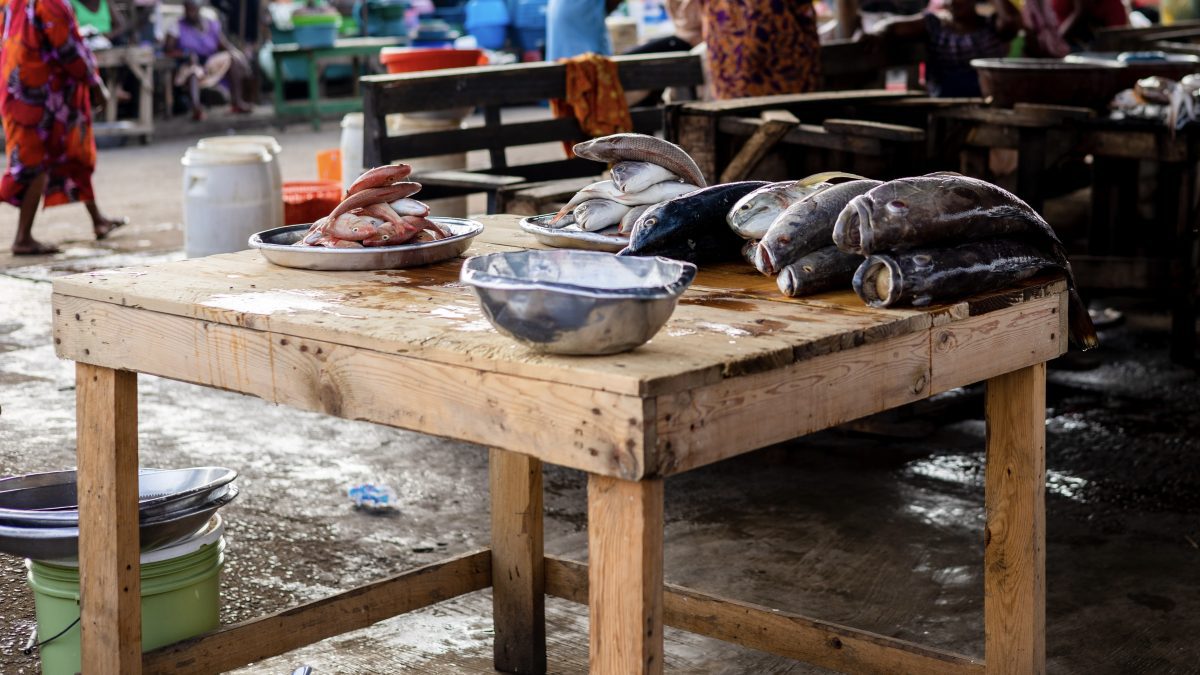For developing countries, seafood imports are a nutritional bargain
 Fish ready to be sold at a market in Accra, Ghana. (Photo by: Praise Nuna Nkowrnyui, ©Woods Hole Oceanographic Institution)
Fish ready to be sold at a market in Accra, Ghana. (Photo by: Praise Nuna Nkowrnyui, ©Woods Hole Oceanographic Institution) July 1, 2025
Developing countries pay less for the nutrition in seafood imports than developed countries
Woods Hole, Mass. (July 1, 2025) -- Developing countries pay less for the nutrition in seafood imports than developed countries, largely because developed countries pay a premium for non-nutritional attributes such as convenience, according to a new economic analysis appearing in Nature Communications. The findings suggest that disruptions to the global seafood trade could affect food and nutritional security in countries that depend on seafood imports for meeting their dietary needs.
"Every way we sliced the data, the outcome was the same: developing countries get more nutrition for every dollar they spend on imports compared to wealthier nations," said Marine (Yaqin) Liu, first author on the study and environmental economist at the Woods Hole Oceanographic Institution (WHOI). "They’re getting more protein, more fatty acids, more iron, and more vitamin B12. That’s because they aren’t paying a premium for the non-nutritional traits that developed countries tend to value more."
Seafood, which comes from marine and freshwater environments, is the top-traded food commodity in the world and plays an outsize role in food security. More than a third of the global population relies on seafood for at least 20% of their animal protein intake. Fish and shellfish also provide key nutrients, including heart-healthy fatty acids, as well as essential vitamins and minerals — or micronutrients — such as B12 and calcium.
“We mostly take micronutrients for granted in high-income, developed countries, partly because we fortify foods and partly because we just have a lot of them in our diets already from eating a lot of animal products. But micronutrient deficiencies are a real problem for many developing countries,” said Martin Smith, George M. Woodwell Distinguished Professor of Environmental Economics in the Nicholas School of the Environment at Duke University, who designed the study.
Because developing countries tend to export more expensive seafood and import less expensive seafood, the researchers wondered: Are those countries sacrificing nutrition for lower-cost goods?
To answer that question, the team combined information from two large databases: The first, called United Nations Comtrade, provides global trade data on both wild-caught and farmed seafood. The second database, managed by the Food and Agriculture Organization of the United Nations, provides detailed nutritional information categorized by seafood species and product type, such as frozen or fresh fish, and whole or fillet.
“By linking these two databases together, we could match nutrient content with the specific seafood products exchanging hands,” Liu said.
Focusing on the years 2015 to 2021, the researchers analyzed 266 unique seafood products representing 90% of the global seafood trade. Then, they used six different methods to classify each importing country as either developed or developing based on several socioeconomic factors, such as gross domestic product and food insecurity. All told, the team examined 267,505 records on bilateral trade, or the exchange of goods between two countries.
“We’re the first team to do this analysis in the seafood trade sector,” Liu continued.
For each of those records, they then calculated the nutrient content per dollar for each of nine nutrients — including protein, fatty acids, vitamin B12, calcium, iron, zinc, potassium and magnesium. They consistently found that developing countries, which are typically low- and middle-income countries, pay lower prices for nutrition in imported seafood than developed countries.
For example, a pound of fresh salmon and a pound of frozen salmon have approximately the same amount of protein, but because developing countries pay less for frozen fish, they essentially get more protein per dollar.
“When it comes to seafood imports, developing countries get more nutritional bang for their buck,” said co-author Joshua Abbott, a professor of sustainability at Arizona State University.
Researchers also found that the discrepancy between developed and developing countries largely reflects differences in preference for seafood qualities unrelated to nutrition.
“Seafood consumers in the United States, Japan, the European Union, and other high-income countries are paying a high premium for getting more fresh fish into their markets, even though it’s not more nutritious,” Smith explained. “When wealthier countries pay extra for freshness, that creates an opportunity for lower-income countries to import frozen fish for a lower price and still get that nutrition.”
From a global health perspective, the findings are encouraging, according to the authors.
“We initially worried that the lower cost of seafood imports might reflect lower nutritional value,” Liu said. “But our research shows that’s not the case. In fact, our findings indicate that any disruption to global seafood trade could negatively impact nutrition in developing countries.”
###
About Woods Hole Oceanographic Institution
Woods Hole Oceanographic Institution (WHOI) is a private, non-profit organization on Cape Cod, Massachusetts, dedicated to marine research, engineering, and higher education. Established in 1930, its mission is to understand the ocean and its interactions with the Earth as a whole, and to communicate an understanding of the ocean’s role in the changing global environment. WHOI’s pioneering discoveries stem from an ideal combination of science and engineering—one that has made it one of the most trusted and technically advanced leaders in fundamental and applied ocean research and exploration anywhere. WHOI is known for its multidisciplinary approach, superior ship operations, and unparalleled deep-sea robotics capabilities. We play a leading role in ocean observation and operate the most extensive suite of ocean data-gathering platforms in the world. Top scientists, engineers, and students collaborate on more than 800 concurrent projects worldwide—both above and below the waves—pushing the boundaries of knowledge to inform people and policies for a healthier planet. Learn more at whoi.edu.
